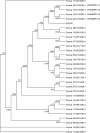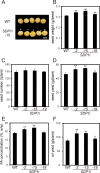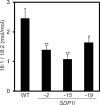Soybean (Glycine max L.) triacylglycerol lipase GmSDP1 regulates the quality and quantity of seed oil
- PMID: 31222045
- PMCID: PMC6586785
- DOI: 10.1038/s41598-019-45331-8
Soybean (Glycine max L.) triacylglycerol lipase GmSDP1 regulates the quality and quantity of seed oil
Abstract
Seeds of soybean (Glycine max L.) are a major source of plant-derived oils. In the past, improvements have been made in the quantity and quality of seed oil. Triacylglycerols (TAGs) are the principal components of soybean seed oil, and understanding the metabolic regulation of TAGs in soybean seeds is essential. Here, we identified four soybean genes encoding TAG lipases, designated as SUGAR DEPENDENT1-1 (GmSDP1-1), GmSDP1-2, GmSDP1-3 and GmSDP1-4; these are homologous to Arabidopsis thaliana SDP1 (AtSDP1). To characterize the function of these genes during grain filling, transgenic lines of soybean were generated via RNA interference to knockdown the expression of all four GmSDP1 genes. The seed oil content of the transgenic soybean lines was significantly increased compared with the wild type (WT). Additionally, fatty acid profiles of the WT and transgenic soybean lines were altered; the content of linoleic acid, a major fatty acid in soybean seeds, was significantly reduced, whereas that of oleic acid was increased in transgenic soybean seeds compared with the WT. Substrate specificity experiments showed that TAG lipase preferentially cleaved oleic acid than linoleic acid in the oil body membrane in WT soybean. This study demonstrates that the GmSDP1 proteins regulate both the TAG content and fatty acid composition of soybean seeds during grain filling. These results provide a novel strategy for improving both the quantity and quality of soybean seed oil.
Conflict of interest statement
The authors declare no competing interests.
Figures







Similar articles
-
[Seed-specific expression of heterologous gene DGAT1 increase soybean seed oil content and nutritional quality].Sheng Wu Gong Cheng Xue Bao. 2018 Sep 25;34(9):1478-1490. doi: 10.13345/j.cjb.180236. Sheng Wu Gong Cheng Xue Bao. 2018. PMID: 30255682 Chinese.
-
Soybean (Glycine max) WRINKLED1 transcription factor, GmWRI1a, positively regulates seed oil accumulation.Mol Genet Genomics. 2018 Apr;293(2):401-415. doi: 10.1007/s00438-017-1393-2. Epub 2017 Nov 14. Mol Genet Genomics. 2018. PMID: 29138932
-
Overexpression of soybean GmPLDγ enhances seed oil content and modulates fatty acid composition in transgenic Arabidopsis.Plant Sci. 2020 Jan;290:110298. doi: 10.1016/j.plantsci.2019.110298. Epub 2019 Oct 6. Plant Sci. 2020. PMID: 31779909
-
Storage oil hydrolysis during early seedling growth.Plant Physiol Biochem. 2009 Jun;47(6):485-90. doi: 10.1016/j.plaphy.2008.12.005. Epub 2008 Dec 16. Plant Physiol Biochem. 2009. PMID: 19136267 Review.
-
Regulation of Oil Biosynthesis and Genetic Improvement in Plants: Advances and Prospects.Genes (Basel). 2024 Aug 26;15(9):1125. doi: 10.3390/genes15091125. Genes (Basel). 2024. PMID: 39336716 Free PMC article. Review.
Cited by
-
Elevating seed oil content in a polyploid crop by induced mutations in SEED FATTY ACID REDUCER genes.Plant Biotechnol J. 2020 Nov;18(11):2251-2266. doi: 10.1111/pbi.13381. Epub 2020 Apr 13. Plant Biotechnol J. 2020. PMID: 32216029 Free PMC article.
-
Identification of HSSP1 as a regulator of soybean protein content through QTL analysis and Soy-SPCC network.Plant Biotechnol J. 2025 Jul;23(7):2673-2688. doi: 10.1111/pbi.70092. Epub 2025 Apr 18. Plant Biotechnol J. 2025. PMID: 40249859 Free PMC article.
-
On the Inverse Correlation of Protein and Oil: Examining the Effects of Altered Central Carbon Metabolism on Seed Composition Using Soybean Fast Neutron Mutants.Metabolites. 2019 Dec 28;10(1):18. doi: 10.3390/metabo10010018. Metabolites. 2019. PMID: 31905618 Free PMC article.
-
Application of SVR-Mediated GWAS for Identification of Durable Genetic Regions Associated with Soybean Seed Quality Traits.Plants (Basel). 2023 Jul 16;12(14):2659. doi: 10.3390/plants12142659. Plants (Basel). 2023. PMID: 37514272 Free PMC article.
-
Metabolic flux analysis to increase oil in seeds.Plant Physiol. 2025 Feb 7;197(2):kiae595. doi: 10.1093/plphys/kiae595. Plant Physiol. 2025. PMID: 39499667 Free PMC article. Review.
References
Publication types
MeSH terms
Substances
LinkOut - more resources
Full Text Sources
Other Literature Sources
Miscellaneous

